Marketing for Managers: Analysis and Recommendations for Toyota Motor Corporation in Singapore
VerifiedAdded on 2023/01/20
|21
|4115
|88
AI Summary
This report provides a detailed analysis of the marketing strategy of Toyota Motor Corporation in Singapore and offers recommendations for improvement. It covers the macro environment forces impacting the automobile industry, possible segmentation strategies, recommended primary research techniques, and an analysis of the marketing mix strategies.
Contribute Materials
Your contribution can guide someone’s learning journey. Share your
documents today.

Marketing for managers
Secure Best Marks with AI Grader
Need help grading? Try our AI Grader for instant feedback on your assignments.
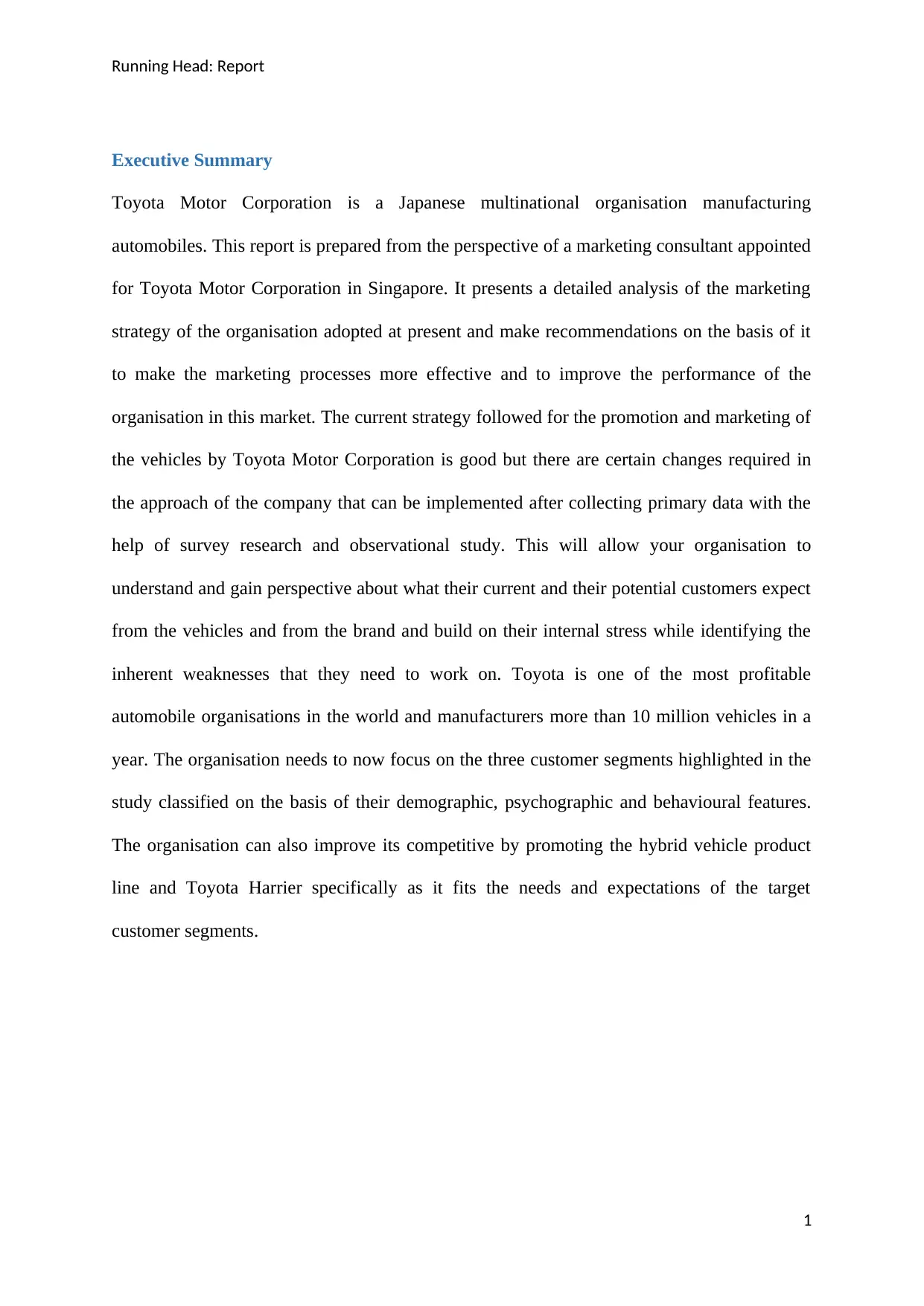
Running Head: Report
Executive Summary
Toyota Motor Corporation is a Japanese multinational organisation manufacturing
automobiles. This report is prepared from the perspective of a marketing consultant appointed
for Toyota Motor Corporation in Singapore. It presents a detailed analysis of the marketing
strategy of the organisation adopted at present and make recommendations on the basis of it
to make the marketing processes more effective and to improve the performance of the
organisation in this market. The current strategy followed for the promotion and marketing of
the vehicles by Toyota Motor Corporation is good but there are certain changes required in
the approach of the company that can be implemented after collecting primary data with the
help of survey research and observational study. This will allow your organisation to
understand and gain perspective about what their current and their potential customers expect
from the vehicles and from the brand and build on their internal stress while identifying the
inherent weaknesses that they need to work on. Toyota is one of the most profitable
automobile organisations in the world and manufacturers more than 10 million vehicles in a
year. The organisation needs to now focus on the three customer segments highlighted in the
study classified on the basis of their demographic, psychographic and behavioural features.
The organisation can also improve its competitive by promoting the hybrid vehicle product
line and Toyota Harrier specifically as it fits the needs and expectations of the target
customer segments.
1
Executive Summary
Toyota Motor Corporation is a Japanese multinational organisation manufacturing
automobiles. This report is prepared from the perspective of a marketing consultant appointed
for Toyota Motor Corporation in Singapore. It presents a detailed analysis of the marketing
strategy of the organisation adopted at present and make recommendations on the basis of it
to make the marketing processes more effective and to improve the performance of the
organisation in this market. The current strategy followed for the promotion and marketing of
the vehicles by Toyota Motor Corporation is good but there are certain changes required in
the approach of the company that can be implemented after collecting primary data with the
help of survey research and observational study. This will allow your organisation to
understand and gain perspective about what their current and their potential customers expect
from the vehicles and from the brand and build on their internal stress while identifying the
inherent weaknesses that they need to work on. Toyota is one of the most profitable
automobile organisations in the world and manufacturers more than 10 million vehicles in a
year. The organisation needs to now focus on the three customer segments highlighted in the
study classified on the basis of their demographic, psychographic and behavioural features.
The organisation can also improve its competitive by promoting the hybrid vehicle product
line and Toyota Harrier specifically as it fits the needs and expectations of the target
customer segments.
1

Running Head: Report
Contents
Executive Summary...............................................................................................................................1
Business Background............................................................................................................................3
Macro environment forces impacting the automobile industry in Singapore.........................................4
Political forces...................................................................................................................................5
Technological forces..........................................................................................................................5
Socio-cultural forces..........................................................................................................................6
Possible basis of segmentation for Toyota in Singapore........................................................................7
Demographic segment.......................................................................................................................7
Psychographic segment.....................................................................................................................7
Behavioural segment.........................................................................................................................8
Recommended primary research techniques..........................................................................................9
Survey research.................................................................................................................................9
Observational research....................................................................................................................10
Marketing strategy analysis.................................................................................................................11
Marketing mix strategies.................................................................................................................11
Product............................................................................................................................................11
Pricing.............................................................................................................................................11
Promotion........................................................................................................................................11
Place................................................................................................................................................12
Improving competitiveness..............................................................................................................13
3 types of Services used in marketing strategies..................................................................................14
People..............................................................................................................................................14
Processes.........................................................................................................................................16
Physical evidence............................................................................................................................16
Conclusion & recommendations..........................................................................................................17
References...........................................................................................................................................18
2
Contents
Executive Summary...............................................................................................................................1
Business Background............................................................................................................................3
Macro environment forces impacting the automobile industry in Singapore.........................................4
Political forces...................................................................................................................................5
Technological forces..........................................................................................................................5
Socio-cultural forces..........................................................................................................................6
Possible basis of segmentation for Toyota in Singapore........................................................................7
Demographic segment.......................................................................................................................7
Psychographic segment.....................................................................................................................7
Behavioural segment.........................................................................................................................8
Recommended primary research techniques..........................................................................................9
Survey research.................................................................................................................................9
Observational research....................................................................................................................10
Marketing strategy analysis.................................................................................................................11
Marketing mix strategies.................................................................................................................11
Product............................................................................................................................................11
Pricing.............................................................................................................................................11
Promotion........................................................................................................................................11
Place................................................................................................................................................12
Improving competitiveness..............................................................................................................13
3 types of Services used in marketing strategies..................................................................................14
People..............................................................................................................................................14
Processes.........................................................................................................................................16
Physical evidence............................................................................................................................16
Conclusion & recommendations..........................................................................................................17
References...........................................................................................................................................18
2
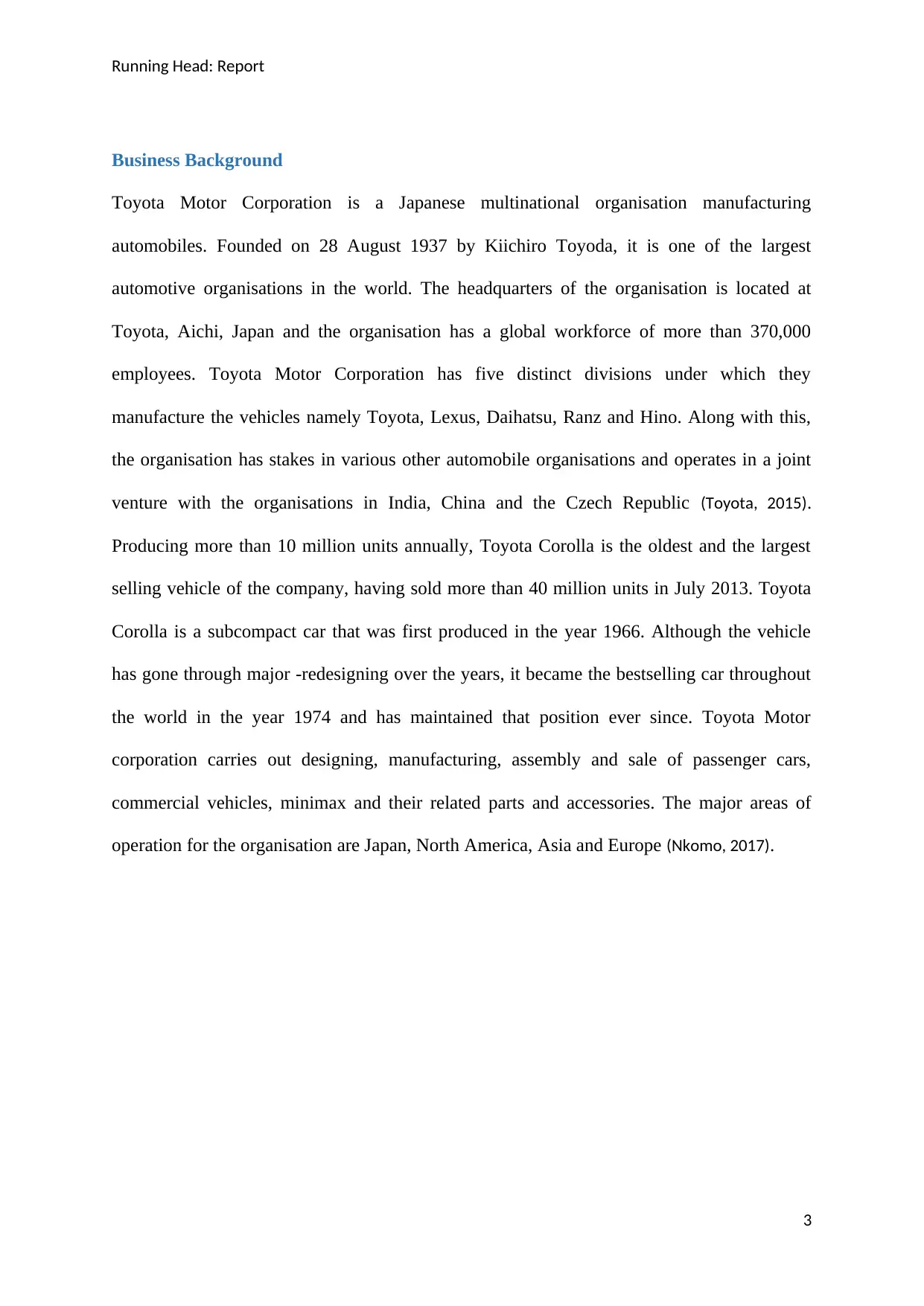
Running Head: Report
Business Background
Toyota Motor Corporation is a Japanese multinational organisation manufacturing
automobiles. Founded on 28 August 1937 by Kiichiro Toyoda, it is one of the largest
automotive organisations in the world. The headquarters of the organisation is located at
Toyota, Aichi, Japan and the organisation has a global workforce of more than 370,000
employees. Toyota Motor Corporation has five distinct divisions under which they
manufacture the vehicles namely Toyota, Lexus, Daihatsu, Ranz and Hino. Along with this,
the organisation has stakes in various other automobile organisations and operates in a joint
venture with the organisations in India, China and the Czech Republic (Toyota, 2015).
Producing more than 10 million units annually, Toyota Corolla is the oldest and the largest
selling vehicle of the company, having sold more than 40 million units in July 2013. Toyota
Corolla is a subcompact car that was first produced in the year 1966. Although the vehicle
has gone through major -redesigning over the years, it became the bestselling car throughout
the world in the year 1974 and has maintained that position ever since. Toyota Motor
corporation carries out designing, manufacturing, assembly and sale of passenger cars,
commercial vehicles, minimax and their related parts and accessories. The major areas of
operation for the organisation are Japan, North America, Asia and Europe (Nkomo, 2017).
3
Business Background
Toyota Motor Corporation is a Japanese multinational organisation manufacturing
automobiles. Founded on 28 August 1937 by Kiichiro Toyoda, it is one of the largest
automotive organisations in the world. The headquarters of the organisation is located at
Toyota, Aichi, Japan and the organisation has a global workforce of more than 370,000
employees. Toyota Motor Corporation has five distinct divisions under which they
manufacture the vehicles namely Toyota, Lexus, Daihatsu, Ranz and Hino. Along with this,
the organisation has stakes in various other automobile organisations and operates in a joint
venture with the organisations in India, China and the Czech Republic (Toyota, 2015).
Producing more than 10 million units annually, Toyota Corolla is the oldest and the largest
selling vehicle of the company, having sold more than 40 million units in July 2013. Toyota
Corolla is a subcompact car that was first produced in the year 1966. Although the vehicle
has gone through major -redesigning over the years, it became the bestselling car throughout
the world in the year 1974 and has maintained that position ever since. Toyota Motor
corporation carries out designing, manufacturing, assembly and sale of passenger cars,
commercial vehicles, minimax and their related parts and accessories. The major areas of
operation for the organisation are Japan, North America, Asia and Europe (Nkomo, 2017).
3
Secure Best Marks with AI Grader
Need help grading? Try our AI Grader for instant feedback on your assignments.

Running Head: Report
The global market shares of Toyota Motor Corporation for the year 2018 was 9.46% what's
the highest among all the brands and automotive organisations. The closest competitors to
Toyota when it comes to the global automobile market are Volkswagen, Ford, Nissan, Honda
and Hyundai.
Macro environment forces impacting the automobile industry in Singapore
The macro environmental factors are the factors related to the external environment of the
industry that impacts its operations and profitability. The macro environment comprises of
the demographic, economic, technological, political and socio-cultural forces that shape the
industry, buying behaviour of the customers and their expectations. The three most
significant macro environmental forces influencing the automobile industry in Singapore are
discussed in this section (Barter, 2015).
4
The global market shares of Toyota Motor Corporation for the year 2018 was 9.46% what's
the highest among all the brands and automotive organisations. The closest competitors to
Toyota when it comes to the global automobile market are Volkswagen, Ford, Nissan, Honda
and Hyundai.
Macro environment forces impacting the automobile industry in Singapore
The macro environmental factors are the factors related to the external environment of the
industry that impacts its operations and profitability. The macro environment comprises of
the demographic, economic, technological, political and socio-cultural forces that shape the
industry, buying behaviour of the customers and their expectations. The three most
significant macro environmental forces influencing the automobile industry in Singapore are
discussed in this section (Barter, 2015).
4
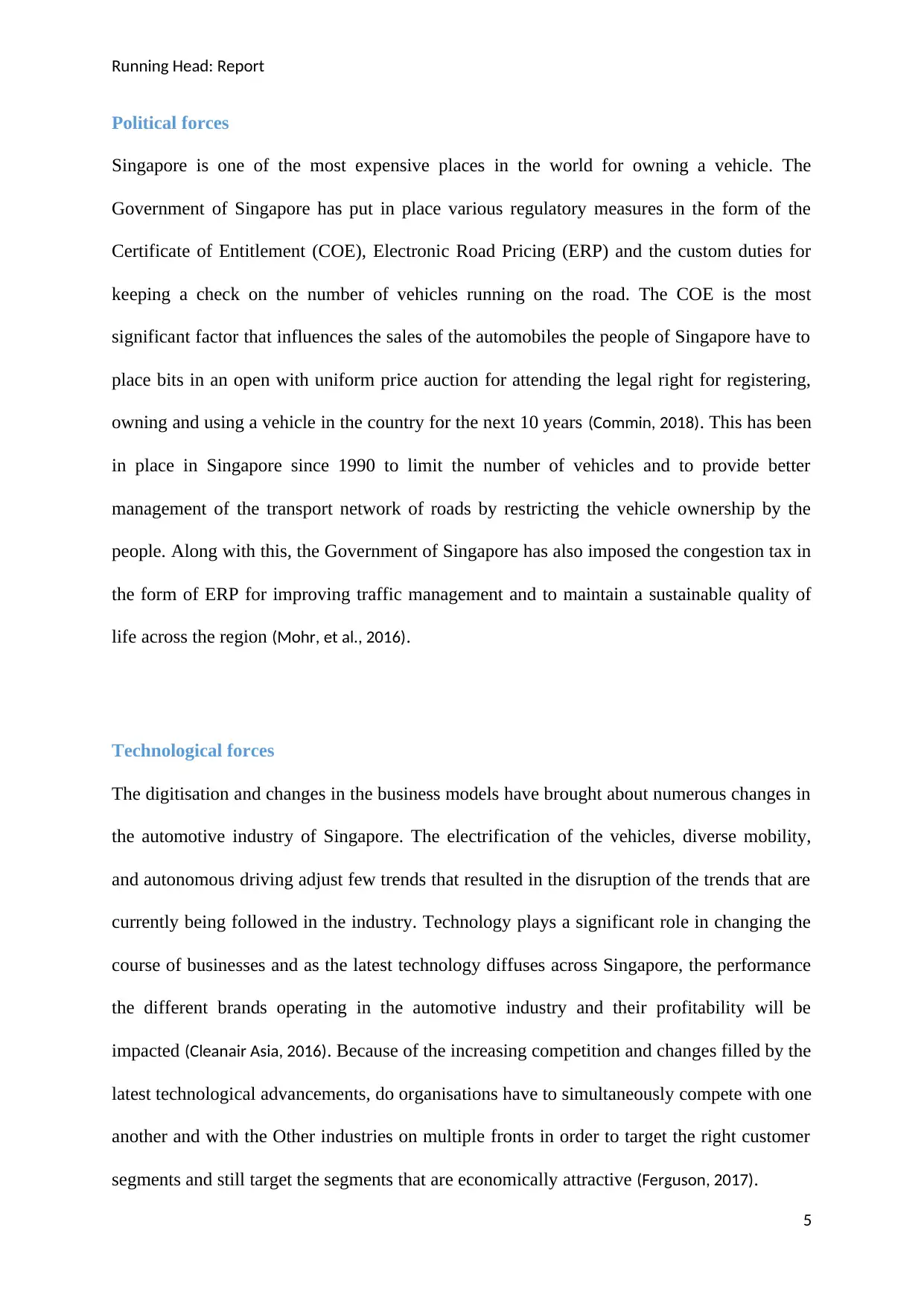
Running Head: Report
Political forces
Singapore is one of the most expensive places in the world for owning a vehicle. The
Government of Singapore has put in place various regulatory measures in the form of the
Certificate of Entitlement (COE), Electronic Road Pricing (ERP) and the custom duties for
keeping a check on the number of vehicles running on the road. The COE is the most
significant factor that influences the sales of the automobiles the people of Singapore have to
place bits in an open with uniform price auction for attending the legal right for registering,
owning and using a vehicle in the country for the next 10 years (Commin, 2018). This has been
in place in Singapore since 1990 to limit the number of vehicles and to provide better
management of the transport network of roads by restricting the vehicle ownership by the
people. Along with this, the Government of Singapore has also imposed the congestion tax in
the form of ERP for improving traffic management and to maintain a sustainable quality of
life across the region (Mohr, et al., 2016).
Technological forces
The digitisation and changes in the business models have brought about numerous changes in
the automotive industry of Singapore. The electrification of the vehicles, diverse mobility,
and autonomous driving adjust few trends that resulted in the disruption of the trends that are
currently being followed in the industry. Technology plays a significant role in changing the
course of businesses and as the latest technology diffuses across Singapore, the performance
the different brands operating in the automotive industry and their profitability will be
impacted (Cleanair Asia, 2016). Because of the increasing competition and changes filled by the
latest technological advancements, do organisations have to simultaneously compete with one
another and with the Other industries on multiple fronts in order to target the right customer
segments and still target the segments that are economically attractive (Ferguson, 2017).
5
Political forces
Singapore is one of the most expensive places in the world for owning a vehicle. The
Government of Singapore has put in place various regulatory measures in the form of the
Certificate of Entitlement (COE), Electronic Road Pricing (ERP) and the custom duties for
keeping a check on the number of vehicles running on the road. The COE is the most
significant factor that influences the sales of the automobiles the people of Singapore have to
place bits in an open with uniform price auction for attending the legal right for registering,
owning and using a vehicle in the country for the next 10 years (Commin, 2018). This has been
in place in Singapore since 1990 to limit the number of vehicles and to provide better
management of the transport network of roads by restricting the vehicle ownership by the
people. Along with this, the Government of Singapore has also imposed the congestion tax in
the form of ERP for improving traffic management and to maintain a sustainable quality of
life across the region (Mohr, et al., 2016).
Technological forces
The digitisation and changes in the business models have brought about numerous changes in
the automotive industry of Singapore. The electrification of the vehicles, diverse mobility,
and autonomous driving adjust few trends that resulted in the disruption of the trends that are
currently being followed in the industry. Technology plays a significant role in changing the
course of businesses and as the latest technology diffuses across Singapore, the performance
the different brands operating in the automotive industry and their profitability will be
impacted (Cleanair Asia, 2016). Because of the increasing competition and changes filled by the
latest technological advancements, do organisations have to simultaneously compete with one
another and with the Other industries on multiple fronts in order to target the right customer
segments and still target the segments that are economically attractive (Ferguson, 2017).
5
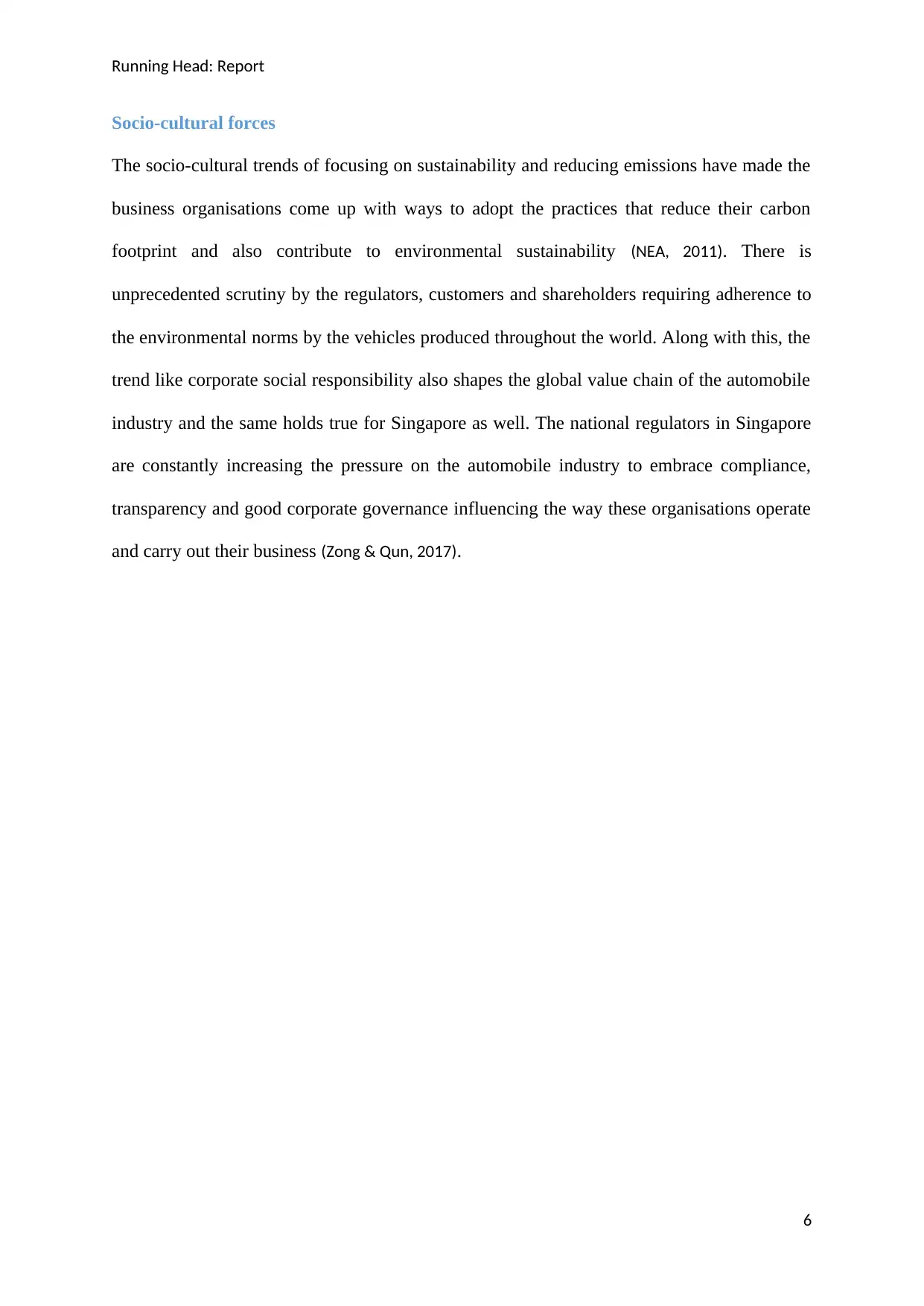
Running Head: Report
Socio-cultural forces
The socio-cultural trends of focusing on sustainability and reducing emissions have made the
business organisations come up with ways to adopt the practices that reduce their carbon
footprint and also contribute to environmental sustainability (NEA, 2011). There is
unprecedented scrutiny by the regulators, customers and shareholders requiring adherence to
the environmental norms by the vehicles produced throughout the world. Along with this, the
trend like corporate social responsibility also shapes the global value chain of the automobile
industry and the same holds true for Singapore as well. The national regulators in Singapore
are constantly increasing the pressure on the automobile industry to embrace compliance,
transparency and good corporate governance influencing the way these organisations operate
and carry out their business (Zong & Qun, 2017).
6
Socio-cultural forces
The socio-cultural trends of focusing on sustainability and reducing emissions have made the
business organisations come up with ways to adopt the practices that reduce their carbon
footprint and also contribute to environmental sustainability (NEA, 2011). There is
unprecedented scrutiny by the regulators, customers and shareholders requiring adherence to
the environmental norms by the vehicles produced throughout the world. Along with this, the
trend like corporate social responsibility also shapes the global value chain of the automobile
industry and the same holds true for Singapore as well. The national regulators in Singapore
are constantly increasing the pressure on the automobile industry to embrace compliance,
transparency and good corporate governance influencing the way these organisations operate
and carry out their business (Zong & Qun, 2017).
6
Paraphrase This Document
Need a fresh take? Get an instant paraphrase of this document with our AI Paraphraser
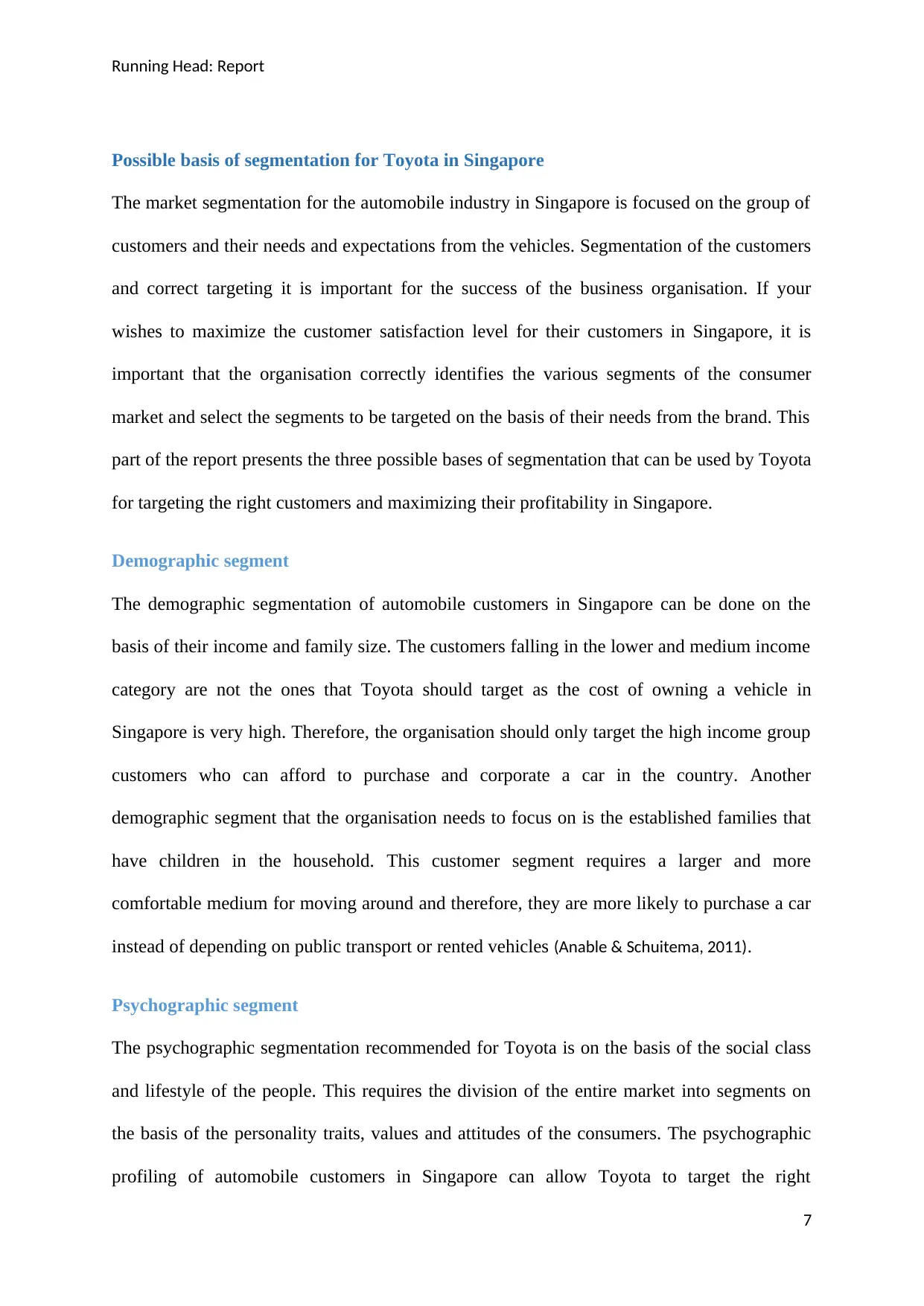
Running Head: Report
Possible basis of segmentation for Toyota in Singapore
The market segmentation for the automobile industry in Singapore is focused on the group of
customers and their needs and expectations from the vehicles. Segmentation of the customers
and correct targeting it is important for the success of the business organisation. If your
wishes to maximize the customer satisfaction level for their customers in Singapore, it is
important that the organisation correctly identifies the various segments of the consumer
market and select the segments to be targeted on the basis of their needs from the brand. This
part of the report presents the three possible bases of segmentation that can be used by Toyota
for targeting the right customers and maximizing their profitability in Singapore.
Demographic segment
The demographic segmentation of automobile customers in Singapore can be done on the
basis of their income and family size. The customers falling in the lower and medium income
category are not the ones that Toyota should target as the cost of owning a vehicle in
Singapore is very high. Therefore, the organisation should only target the high income group
customers who can afford to purchase and corporate a car in the country. Another
demographic segment that the organisation needs to focus on is the established families that
have children in the household. This customer segment requires a larger and more
comfortable medium for moving around and therefore, they are more likely to purchase a car
instead of depending on public transport or rented vehicles (Anable & Schuitema, 2011).
Psychographic segment
The psychographic segmentation recommended for Toyota is on the basis of the social class
and lifestyle of the people. This requires the division of the entire market into segments on
the basis of the personality traits, values and attitudes of the consumers. The psychographic
profiling of automobile customers in Singapore can allow Toyota to target the right
7
Possible basis of segmentation for Toyota in Singapore
The market segmentation for the automobile industry in Singapore is focused on the group of
customers and their needs and expectations from the vehicles. Segmentation of the customers
and correct targeting it is important for the success of the business organisation. If your
wishes to maximize the customer satisfaction level for their customers in Singapore, it is
important that the organisation correctly identifies the various segments of the consumer
market and select the segments to be targeted on the basis of their needs from the brand. This
part of the report presents the three possible bases of segmentation that can be used by Toyota
for targeting the right customers and maximizing their profitability in Singapore.
Demographic segment
The demographic segmentation of automobile customers in Singapore can be done on the
basis of their income and family size. The customers falling in the lower and medium income
category are not the ones that Toyota should target as the cost of owning a vehicle in
Singapore is very high. Therefore, the organisation should only target the high income group
customers who can afford to purchase and corporate a car in the country. Another
demographic segment that the organisation needs to focus on is the established families that
have children in the household. This customer segment requires a larger and more
comfortable medium for moving around and therefore, they are more likely to purchase a car
instead of depending on public transport or rented vehicles (Anable & Schuitema, 2011).
Psychographic segment
The psychographic segmentation recommended for Toyota is on the basis of the social class
and lifestyle of the people. This requires the division of the entire market into segments on
the basis of the personality traits, values and attitudes of the consumers. The psychographic
profiling of automobile customers in Singapore can allow Toyota to target the right
7
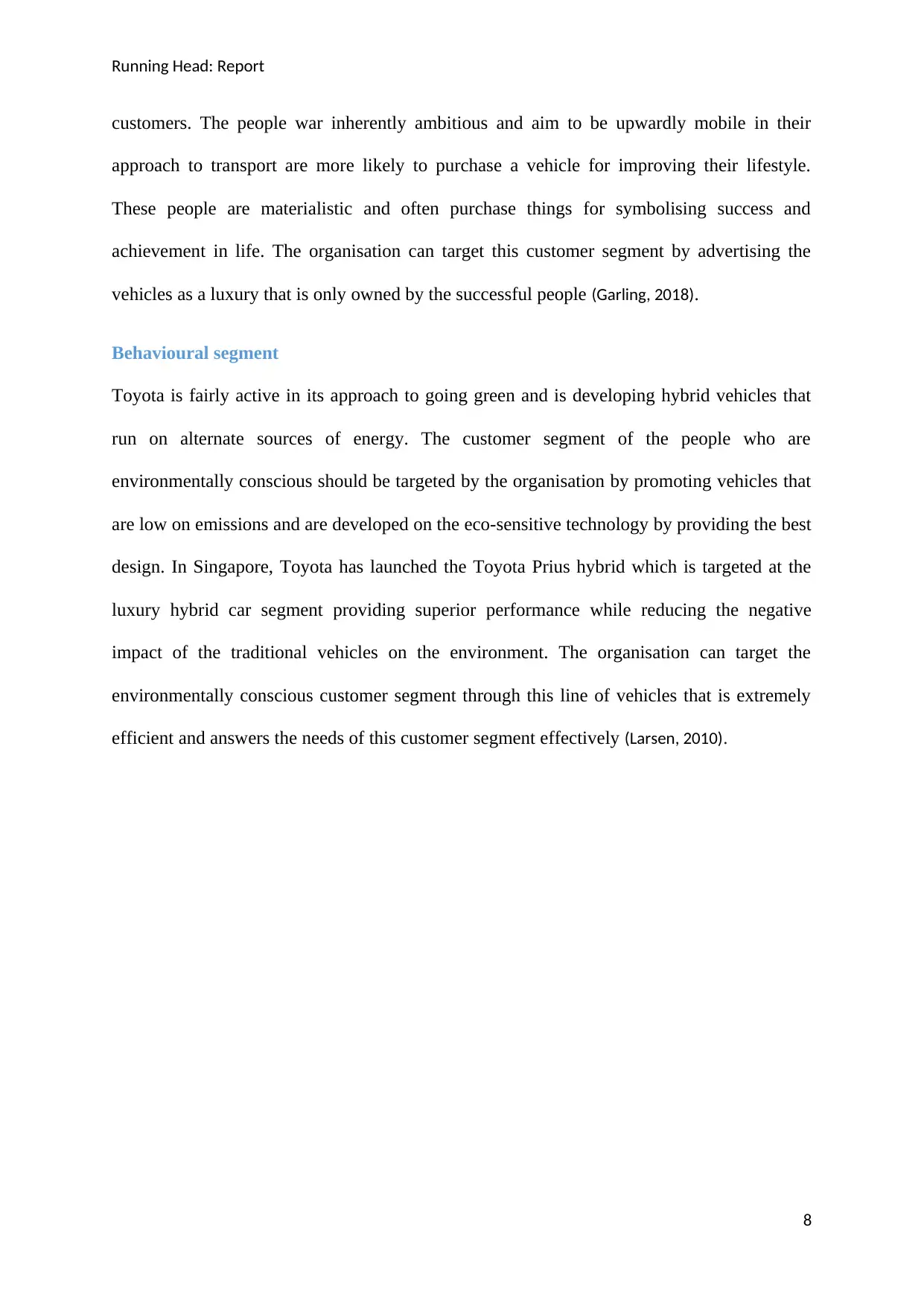
Running Head: Report
customers. The people war inherently ambitious and aim to be upwardly mobile in their
approach to transport are more likely to purchase a vehicle for improving their lifestyle.
These people are materialistic and often purchase things for symbolising success and
achievement in life. The organisation can target this customer segment by advertising the
vehicles as a luxury that is only owned by the successful people (Garling, 2018).
Behavioural segment
Toyota is fairly active in its approach to going green and is developing hybrid vehicles that
run on alternate sources of energy. The customer segment of the people who are
environmentally conscious should be targeted by the organisation by promoting vehicles that
are low on emissions and are developed on the eco-sensitive technology by providing the best
design. In Singapore, Toyota has launched the Toyota Prius hybrid which is targeted at the
luxury hybrid car segment providing superior performance while reducing the negative
impact of the traditional vehicles on the environment. The organisation can target the
environmentally conscious customer segment through this line of vehicles that is extremely
efficient and answers the needs of this customer segment effectively (Larsen, 2010).
8
customers. The people war inherently ambitious and aim to be upwardly mobile in their
approach to transport are more likely to purchase a vehicle for improving their lifestyle.
These people are materialistic and often purchase things for symbolising success and
achievement in life. The organisation can target this customer segment by advertising the
vehicles as a luxury that is only owned by the successful people (Garling, 2018).
Behavioural segment
Toyota is fairly active in its approach to going green and is developing hybrid vehicles that
run on alternate sources of energy. The customer segment of the people who are
environmentally conscious should be targeted by the organisation by promoting vehicles that
are low on emissions and are developed on the eco-sensitive technology by providing the best
design. In Singapore, Toyota has launched the Toyota Prius hybrid which is targeted at the
luxury hybrid car segment providing superior performance while reducing the negative
impact of the traditional vehicles on the environment. The organisation can target the
environmentally conscious customer segment through this line of vehicles that is extremely
efficient and answers the needs of this customer segment effectively (Larsen, 2010).
8
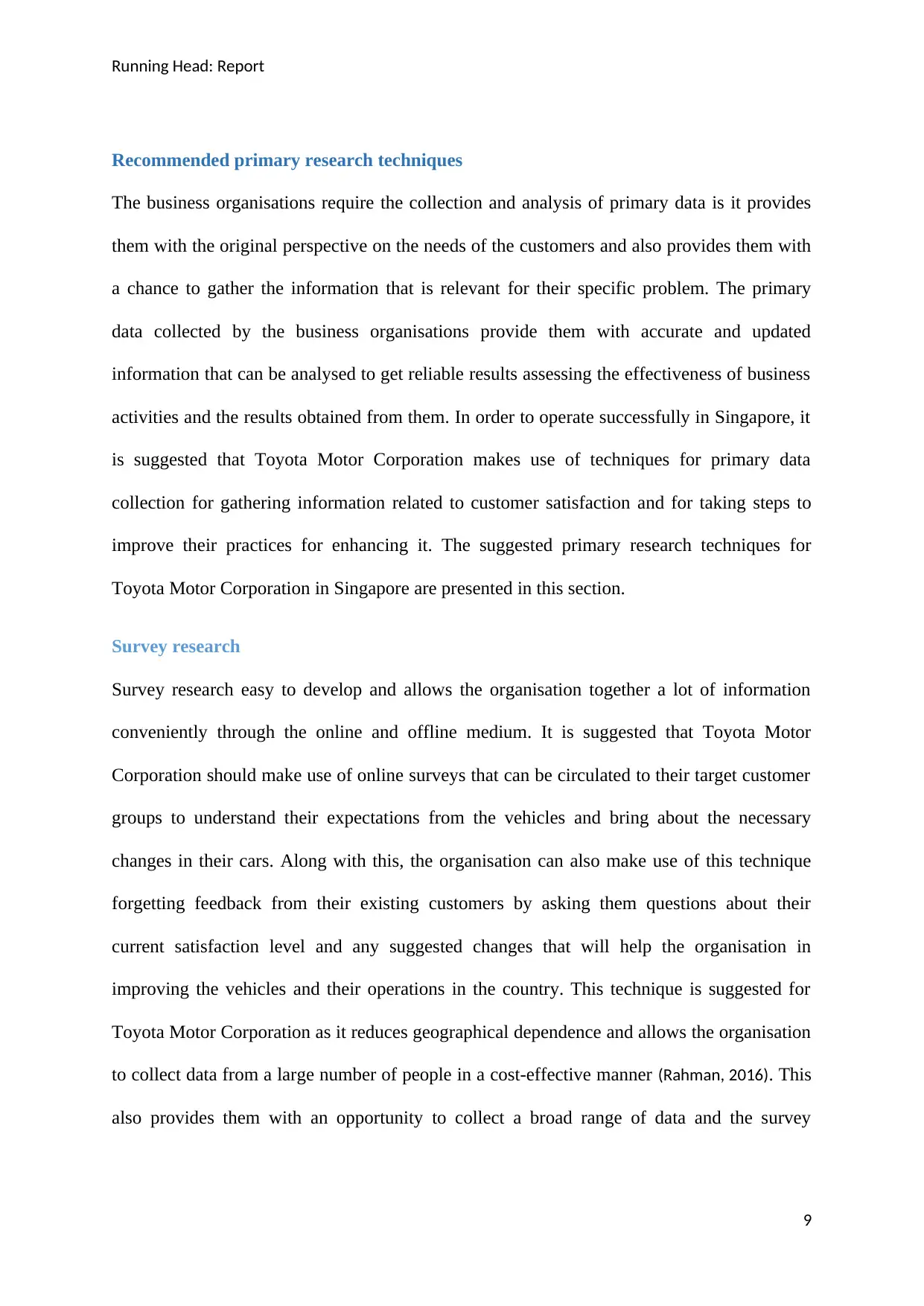
Running Head: Report
Recommended primary research techniques
The business organisations require the collection and analysis of primary data is it provides
them with the original perspective on the needs of the customers and also provides them with
a chance to gather the information that is relevant for their specific problem. The primary
data collected by the business organisations provide them with accurate and updated
information that can be analysed to get reliable results assessing the effectiveness of business
activities and the results obtained from them. In order to operate successfully in Singapore, it
is suggested that Toyota Motor Corporation makes use of techniques for primary data
collection for gathering information related to customer satisfaction and for taking steps to
improve their practices for enhancing it. The suggested primary research techniques for
Toyota Motor Corporation in Singapore are presented in this section.
Survey research
Survey research easy to develop and allows the organisation together a lot of information
conveniently through the online and offline medium. It is suggested that Toyota Motor
Corporation should make use of online surveys that can be circulated to their target customer
groups to understand their expectations from the vehicles and bring about the necessary
changes in their cars. Along with this, the organisation can also make use of this technique
forgetting feedback from their existing customers by asking them questions about their
current satisfaction level and any suggested changes that will help the organisation in
improving the vehicles and their operations in the country. This technique is suggested for
Toyota Motor Corporation as it reduces geographical dependence and allows the organisation
to collect data from a large number of people in a cost-effective manner (Rahman, 2016). This
also provides them with an opportunity to collect a broad range of data and the survey
9
Recommended primary research techniques
The business organisations require the collection and analysis of primary data is it provides
them with the original perspective on the needs of the customers and also provides them with
a chance to gather the information that is relevant for their specific problem. The primary
data collected by the business organisations provide them with accurate and updated
information that can be analysed to get reliable results assessing the effectiveness of business
activities and the results obtained from them. In order to operate successfully in Singapore, it
is suggested that Toyota Motor Corporation makes use of techniques for primary data
collection for gathering information related to customer satisfaction and for taking steps to
improve their practices for enhancing it. The suggested primary research techniques for
Toyota Motor Corporation in Singapore are presented in this section.
Survey research
Survey research easy to develop and allows the organisation together a lot of information
conveniently through the online and offline medium. It is suggested that Toyota Motor
Corporation should make use of online surveys that can be circulated to their target customer
groups to understand their expectations from the vehicles and bring about the necessary
changes in their cars. Along with this, the organisation can also make use of this technique
forgetting feedback from their existing customers by asking them questions about their
current satisfaction level and any suggested changes that will help the organisation in
improving the vehicles and their operations in the country. This technique is suggested for
Toyota Motor Corporation as it reduces geographical dependence and allows the organisation
to collect data from a large number of people in a cost-effective manner (Rahman, 2016). This
also provides them with an opportunity to collect a broad range of data and the survey
9
Secure Best Marks with AI Grader
Need help grading? Try our AI Grader for instant feedback on your assignments.

Running Head: Report
questionnaires can be standardized or customised on the basis of the customer segment from
which the information is to be obtained.
Observational research
The observational research technique is another effective method for data collection for the
Toyota Motor Corporation. The organisation can observe the buying behaviour of the
customers by conducting field research of the organic behaviour demonstrated by the
customers in the natural environment to understand how they react to the marketing
initiatives of Toyota Motor Corporation and how satisfied they are with the vehicles and
options offered to them. The organisation can make use of observational research to gain
significant insights about their behaviour and identify any conscious or subconscious bias that
they may hold towards the brand for their vehicles. Observational research also provides
Toyota Motor Corporation with a real-world perspective by getting a description of the
consumer behaviour instead of taking the decisions based on hypothetical facts and figures or
assumptions made by organisational leaders. Observational research technique is a more
reliable measurement of the actual behaviour demonstrated by the customers as compared to
any other metrics adopted by the company (Toyota Motor Corporation, 2019).
10
questionnaires can be standardized or customised on the basis of the customer segment from
which the information is to be obtained.
Observational research
The observational research technique is another effective method for data collection for the
Toyota Motor Corporation. The organisation can observe the buying behaviour of the
customers by conducting field research of the organic behaviour demonstrated by the
customers in the natural environment to understand how they react to the marketing
initiatives of Toyota Motor Corporation and how satisfied they are with the vehicles and
options offered to them. The organisation can make use of observational research to gain
significant insights about their behaviour and identify any conscious or subconscious bias that
they may hold towards the brand for their vehicles. Observational research also provides
Toyota Motor Corporation with a real-world perspective by getting a description of the
consumer behaviour instead of taking the decisions based on hypothetical facts and figures or
assumptions made by organisational leaders. Observational research technique is a more
reliable measurement of the actual behaviour demonstrated by the customers as compared to
any other metrics adopted by the company (Toyota Motor Corporation, 2019).
10
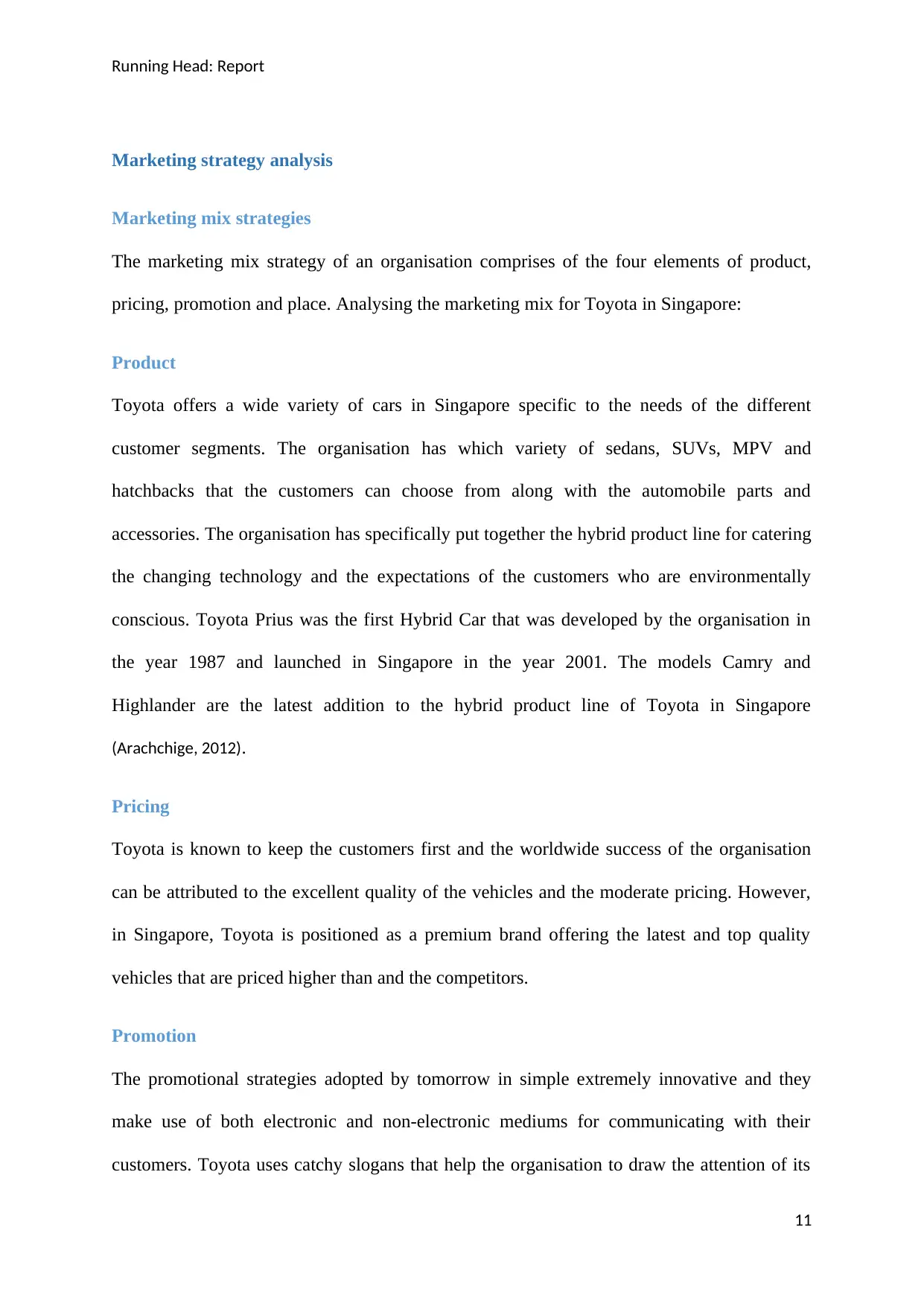
Running Head: Report
Marketing strategy analysis
Marketing mix strategies
The marketing mix strategy of an organisation comprises of the four elements of product,
pricing, promotion and place. Analysing the marketing mix for Toyota in Singapore:
Product
Toyota offers a wide variety of cars in Singapore specific to the needs of the different
customer segments. The organisation has which variety of sedans, SUVs, MPV and
hatchbacks that the customers can choose from along with the automobile parts and
accessories. The organisation has specifically put together the hybrid product line for catering
the changing technology and the expectations of the customers who are environmentally
conscious. Toyota Prius was the first Hybrid Car that was developed by the organisation in
the year 1987 and launched in Singapore in the year 2001. The models Camry and
Highlander are the latest addition to the hybrid product line of Toyota in Singapore
(Arachchige, 2012).
Pricing
Toyota is known to keep the customers first and the worldwide success of the organisation
can be attributed to the excellent quality of the vehicles and the moderate pricing. However,
in Singapore, Toyota is positioned as a premium brand offering the latest and top quality
vehicles that are priced higher than and the competitors.
Promotion
The promotional strategies adopted by tomorrow in simple extremely innovative and they
make use of both electronic and non-electronic mediums for communicating with their
customers. Toyota uses catchy slogans that help the organisation to draw the attention of its
11
Marketing strategy analysis
Marketing mix strategies
The marketing mix strategy of an organisation comprises of the four elements of product,
pricing, promotion and place. Analysing the marketing mix for Toyota in Singapore:
Product
Toyota offers a wide variety of cars in Singapore specific to the needs of the different
customer segments. The organisation has which variety of sedans, SUVs, MPV and
hatchbacks that the customers can choose from along with the automobile parts and
accessories. The organisation has specifically put together the hybrid product line for catering
the changing technology and the expectations of the customers who are environmentally
conscious. Toyota Prius was the first Hybrid Car that was developed by the organisation in
the year 1987 and launched in Singapore in the year 2001. The models Camry and
Highlander are the latest addition to the hybrid product line of Toyota in Singapore
(Arachchige, 2012).
Pricing
Toyota is known to keep the customers first and the worldwide success of the organisation
can be attributed to the excellent quality of the vehicles and the moderate pricing. However,
in Singapore, Toyota is positioned as a premium brand offering the latest and top quality
vehicles that are priced higher than and the competitors.
Promotion
The promotional strategies adopted by tomorrow in simple extremely innovative and they
make use of both electronic and non-electronic mediums for communicating with their
customers. Toyota uses catchy slogans that help the organisation to draw the attention of its
11
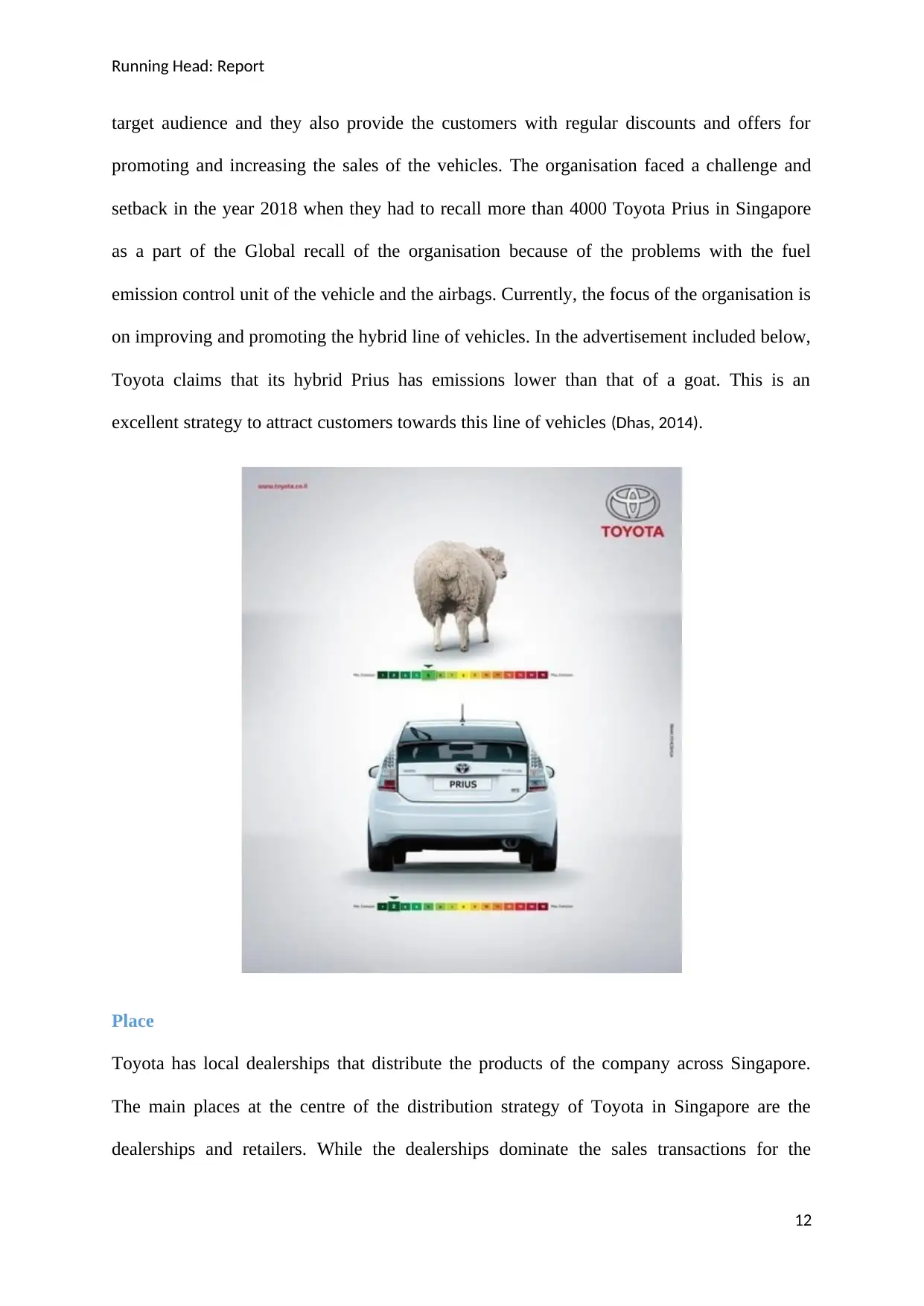
Running Head: Report
target audience and they also provide the customers with regular discounts and offers for
promoting and increasing the sales of the vehicles. The organisation faced a challenge and
setback in the year 2018 when they had to recall more than 4000 Toyota Prius in Singapore
as a part of the Global recall of the organisation because of the problems with the fuel
emission control unit of the vehicle and the airbags. Currently, the focus of the organisation is
on improving and promoting the hybrid line of vehicles. In the advertisement included below,
Toyota claims that its hybrid Prius has emissions lower than that of a goat. This is an
excellent strategy to attract customers towards this line of vehicles (Dhas, 2014).
Place
Toyota has local dealerships that distribute the products of the company across Singapore.
The main places at the centre of the distribution strategy of Toyota in Singapore are the
dealerships and retailers. While the dealerships dominate the sales transactions for the
12
target audience and they also provide the customers with regular discounts and offers for
promoting and increasing the sales of the vehicles. The organisation faced a challenge and
setback in the year 2018 when they had to recall more than 4000 Toyota Prius in Singapore
as a part of the Global recall of the organisation because of the problems with the fuel
emission control unit of the vehicle and the airbags. Currently, the focus of the organisation is
on improving and promoting the hybrid line of vehicles. In the advertisement included below,
Toyota claims that its hybrid Prius has emissions lower than that of a goat. This is an
excellent strategy to attract customers towards this line of vehicles (Dhas, 2014).
Place
Toyota has local dealerships that distribute the products of the company across Singapore.
The main places at the centre of the distribution strategy of Toyota in Singapore are the
dealerships and retailers. While the dealerships dominate the sales transactions for the
12
Paraphrase This Document
Need a fresh take? Get an instant paraphrase of this document with our AI Paraphraser
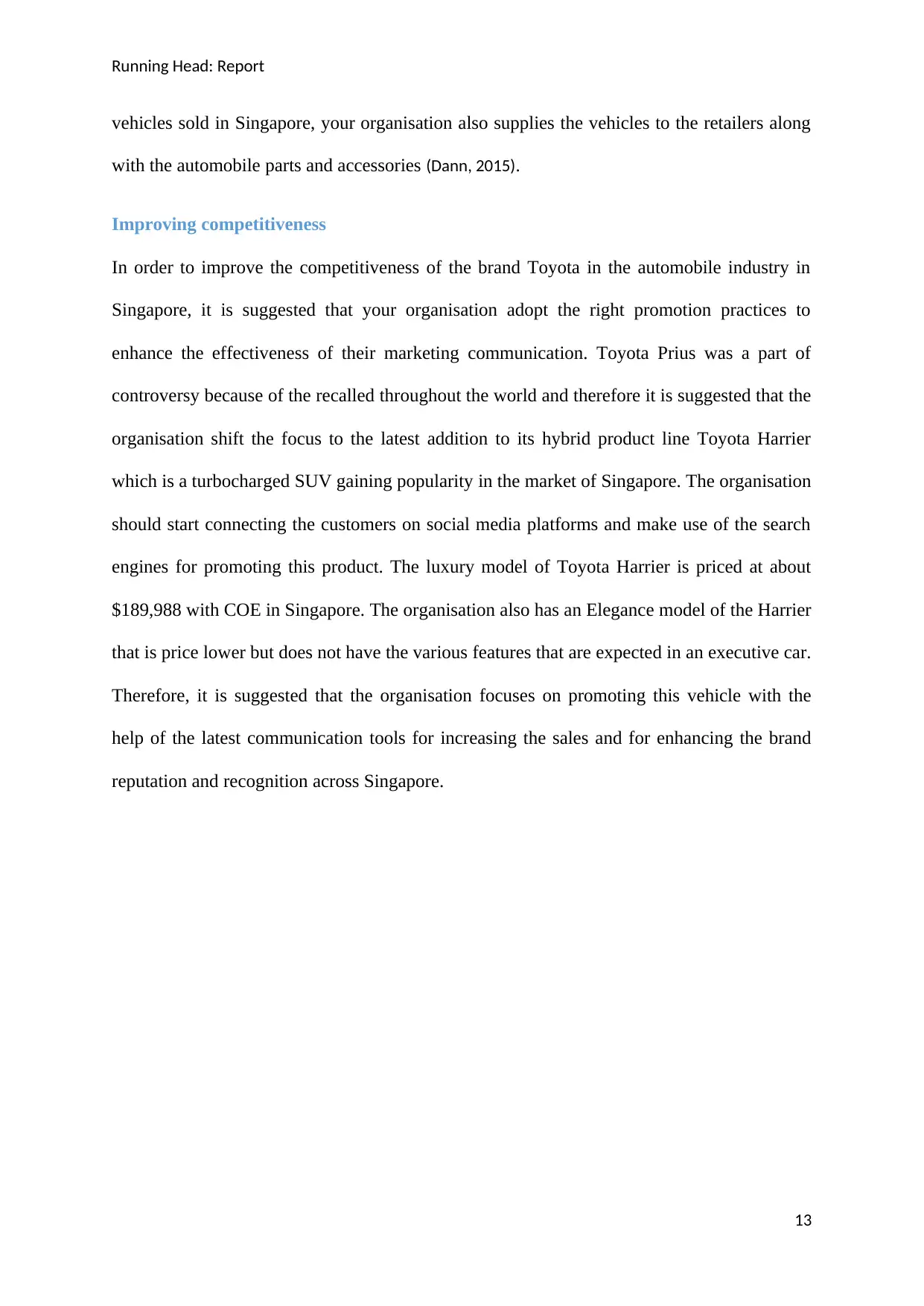
Running Head: Report
vehicles sold in Singapore, your organisation also supplies the vehicles to the retailers along
with the automobile parts and accessories (Dann, 2015).
Improving competitiveness
In order to improve the competitiveness of the brand Toyota in the automobile industry in
Singapore, it is suggested that your organisation adopt the right promotion practices to
enhance the effectiveness of their marketing communication. Toyota Prius was a part of
controversy because of the recalled throughout the world and therefore it is suggested that the
organisation shift the focus to the latest addition to its hybrid product line Toyota Harrier
which is a turbocharged SUV gaining popularity in the market of Singapore. The organisation
should start connecting the customers on social media platforms and make use of the search
engines for promoting this product. The luxury model of Toyota Harrier is priced at about
$189,988 with COE in Singapore. The organisation also has an Elegance model of the Harrier
that is price lower but does not have the various features that are expected in an executive car.
Therefore, it is suggested that the organisation focuses on promoting this vehicle with the
help of the latest communication tools for increasing the sales and for enhancing the brand
reputation and recognition across Singapore.
13
vehicles sold in Singapore, your organisation also supplies the vehicles to the retailers along
with the automobile parts and accessories (Dann, 2015).
Improving competitiveness
In order to improve the competitiveness of the brand Toyota in the automobile industry in
Singapore, it is suggested that your organisation adopt the right promotion practices to
enhance the effectiveness of their marketing communication. Toyota Prius was a part of
controversy because of the recalled throughout the world and therefore it is suggested that the
organisation shift the focus to the latest addition to its hybrid product line Toyota Harrier
which is a turbocharged SUV gaining popularity in the market of Singapore. The organisation
should start connecting the customers on social media platforms and make use of the search
engines for promoting this product. The luxury model of Toyota Harrier is priced at about
$189,988 with COE in Singapore. The organisation also has an Elegance model of the Harrier
that is price lower but does not have the various features that are expected in an executive car.
Therefore, it is suggested that the organisation focuses on promoting this vehicle with the
help of the latest communication tools for increasing the sales and for enhancing the brand
reputation and recognition across Singapore.
13
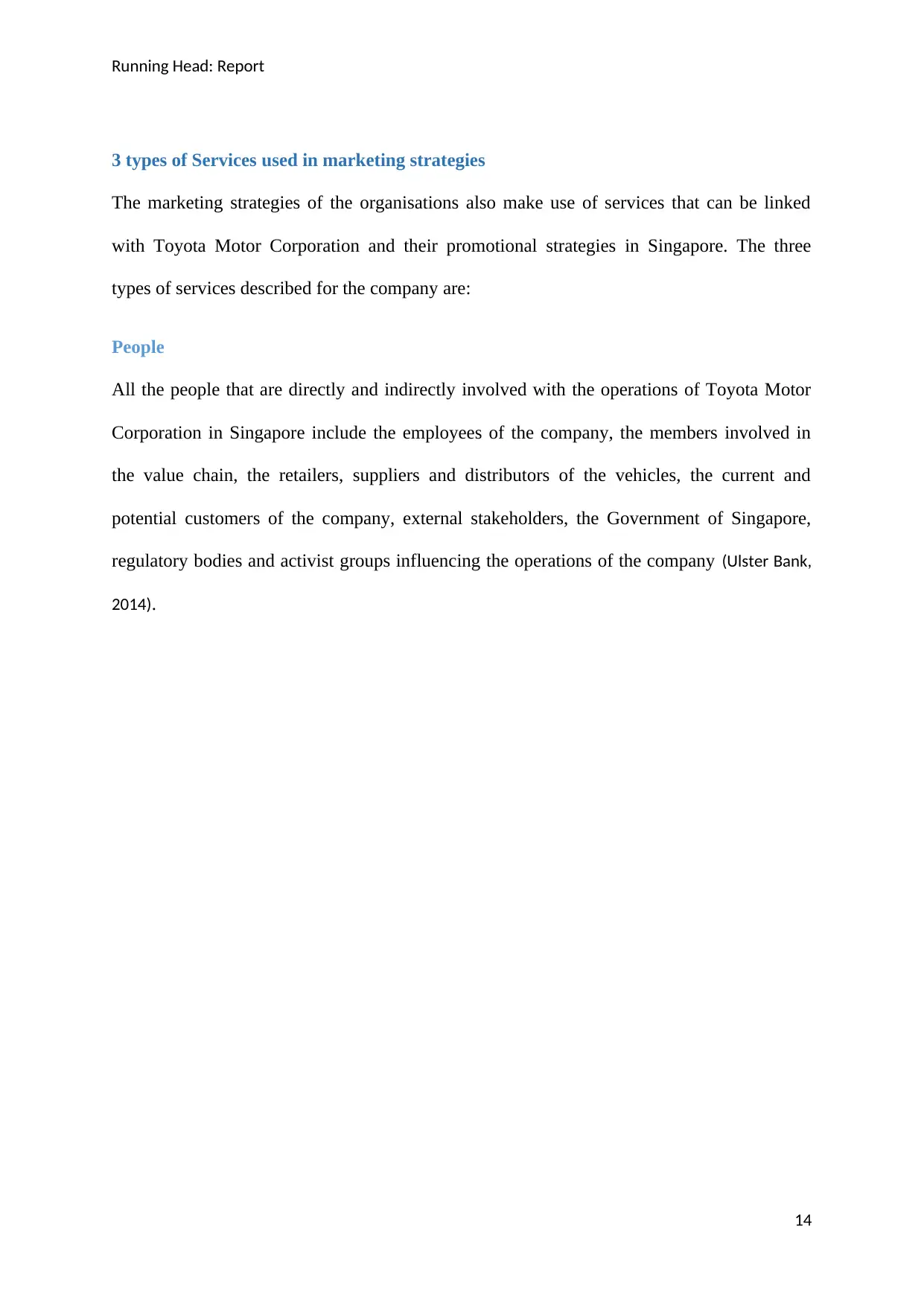
Running Head: Report
3 types of Services used in marketing strategies
The marketing strategies of the organisations also make use of services that can be linked
with Toyota Motor Corporation and their promotional strategies in Singapore. The three
types of services described for the company are:
People
All the people that are directly and indirectly involved with the operations of Toyota Motor
Corporation in Singapore include the employees of the company, the members involved in
the value chain, the retailers, suppliers and distributors of the vehicles, the current and
potential customers of the company, external stakeholders, the Government of Singapore,
regulatory bodies and activist groups influencing the operations of the company (Ulster Bank,
2014).
14
3 types of Services used in marketing strategies
The marketing strategies of the organisations also make use of services that can be linked
with Toyota Motor Corporation and their promotional strategies in Singapore. The three
types of services described for the company are:
People
All the people that are directly and indirectly involved with the operations of Toyota Motor
Corporation in Singapore include the employees of the company, the members involved in
the value chain, the retailers, suppliers and distributors of the vehicles, the current and
potential customers of the company, external stakeholders, the Government of Singapore,
regulatory bodies and activist groups influencing the operations of the company (Ulster Bank,
2014).
14
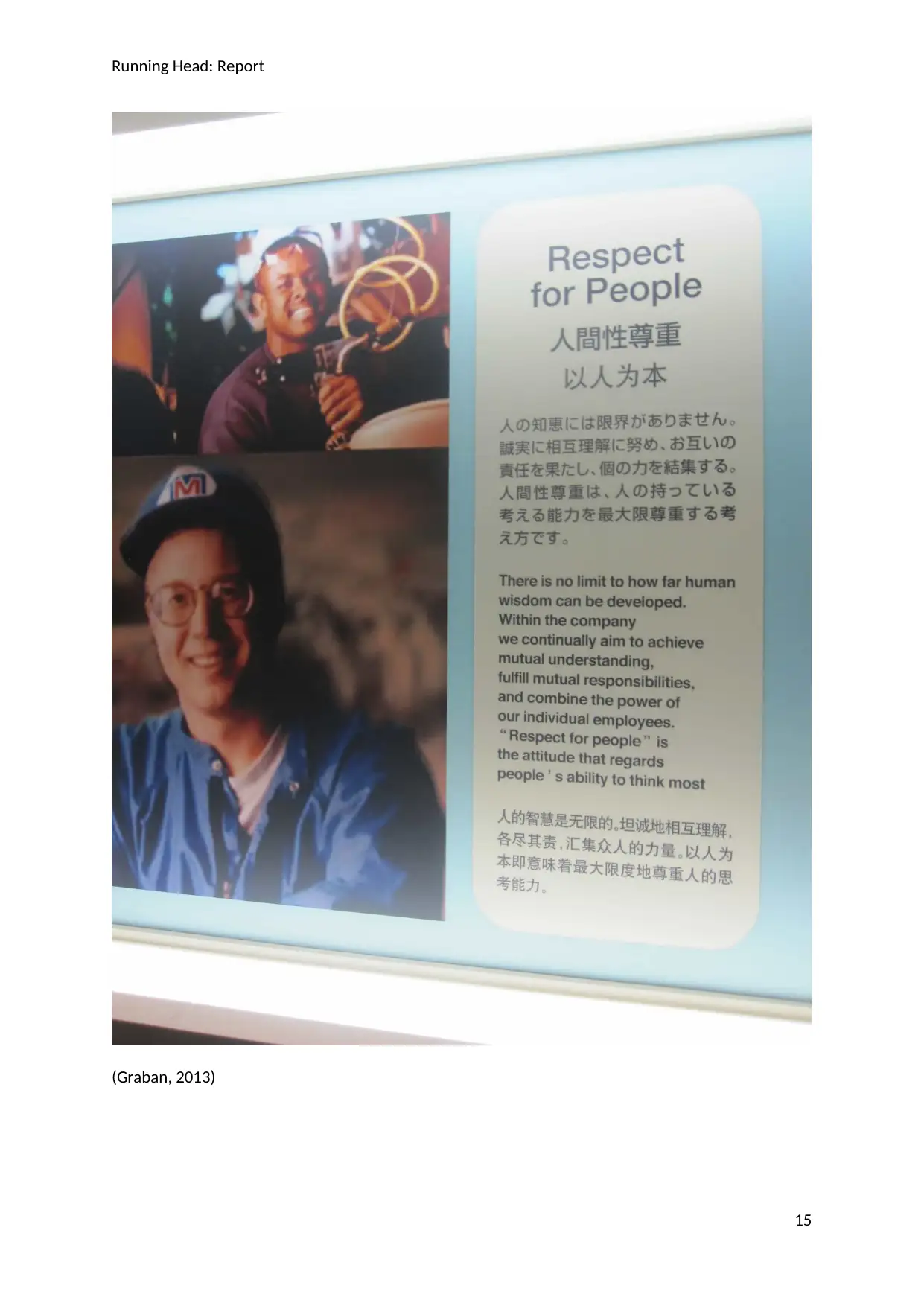
Running Head: Report
(Graban, 2013)
15
(Graban, 2013)
15
Secure Best Marks with AI Grader
Need help grading? Try our AI Grader for instant feedback on your assignments.
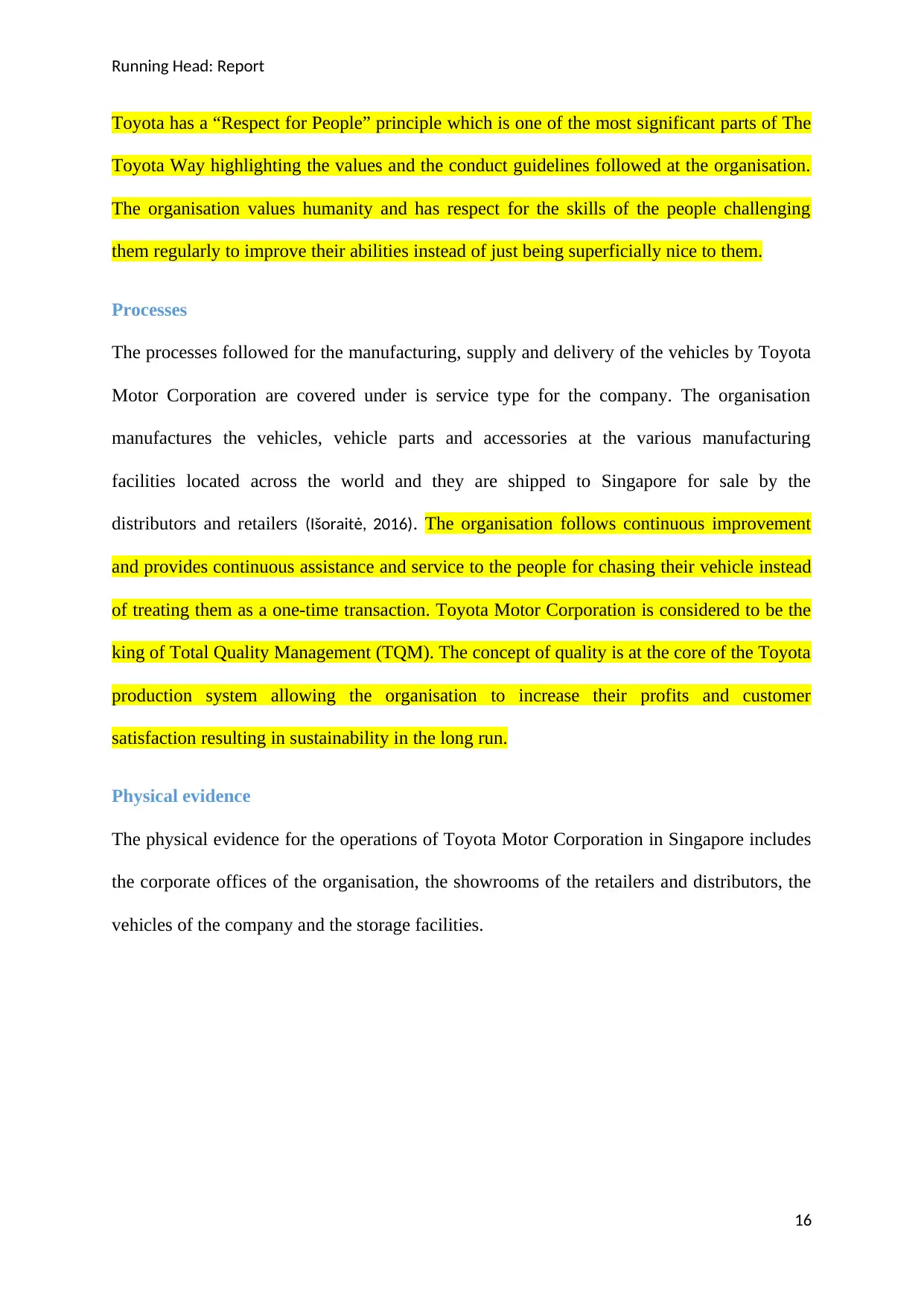
Running Head: Report
Toyota has a “Respect for People” principle which is one of the most significant parts of The
Toyota Way highlighting the values and the conduct guidelines followed at the organisation.
The organisation values humanity and has respect for the skills of the people challenging
them regularly to improve their abilities instead of just being superficially nice to them.
Processes
The processes followed for the manufacturing, supply and delivery of the vehicles by Toyota
Motor Corporation are covered under is service type for the company. The organisation
manufactures the vehicles, vehicle parts and accessories at the various manufacturing
facilities located across the world and they are shipped to Singapore for sale by the
distributors and retailers (Išoraitė, 2016). The organisation follows continuous improvement
and provides continuous assistance and service to the people for chasing their vehicle instead
of treating them as a one-time transaction. Toyota Motor Corporation is considered to be the
king of Total Quality Management (TQM). The concept of quality is at the core of the Toyota
production system allowing the organisation to increase their profits and customer
satisfaction resulting in sustainability in the long run.
Physical evidence
The physical evidence for the operations of Toyota Motor Corporation in Singapore includes
the corporate offices of the organisation, the showrooms of the retailers and distributors, the
vehicles of the company and the storage facilities.
16
Toyota has a “Respect for People” principle which is one of the most significant parts of The
Toyota Way highlighting the values and the conduct guidelines followed at the organisation.
The organisation values humanity and has respect for the skills of the people challenging
them regularly to improve their abilities instead of just being superficially nice to them.
Processes
The processes followed for the manufacturing, supply and delivery of the vehicles by Toyota
Motor Corporation are covered under is service type for the company. The organisation
manufactures the vehicles, vehicle parts and accessories at the various manufacturing
facilities located across the world and they are shipped to Singapore for sale by the
distributors and retailers (Išoraitė, 2016). The organisation follows continuous improvement
and provides continuous assistance and service to the people for chasing their vehicle instead
of treating them as a one-time transaction. Toyota Motor Corporation is considered to be the
king of Total Quality Management (TQM). The concept of quality is at the core of the Toyota
production system allowing the organisation to increase their profits and customer
satisfaction resulting in sustainability in the long run.
Physical evidence
The physical evidence for the operations of Toyota Motor Corporation in Singapore includes
the corporate offices of the organisation, the showrooms of the retailers and distributors, the
vehicles of the company and the storage facilities.
16

Running Head: Report
Conclusion & recommendations
In conclusion, it can be stated that the current strategy followed for the promotion and
marketing of the vehicles by Toyota Motor Corporation is good but there are certain changes
required in the approach of the company that can be implemented after collecting primary
data with the help of survey research and observational study. This will allow your
organisation to understand and gain perspective about what their current and their potential
customers expect from the vehicles and from the brand and build on their internal stress while
identifying the inherent weaknesses that they need to work on. Toyota is one of the most
profitable automobile organisations in the world and manufacturers more than 10 million
vehicles in a year. The organisation needs to now focus on the three customer segments
highlighted in the study classified on the basis of their demographic, psychographic and
behavioural features. The organisation can also improve its competitive by promoting the
hybrid vehicle product line and Toyota Harrier specifically as it fits the needs and
expectations of the target customer segments.
Toyota is known for perfection and for excellent quality management techniques. It is
recommended that the organisation takes advantage of the culture, history and values of
Toyota Motor Corporation and the trust that customers have on the brand when marketing
their products. Toyota Motor Corporation was also one of the first movers in the hybrid
vehicle product segment and your organisation should continue to carry out research and
development in this field to come up with technologically advanced vehicles that run on
alternate sources of energy so that they continue to be a market leader in the coming years as
well.
17
Conclusion & recommendations
In conclusion, it can be stated that the current strategy followed for the promotion and
marketing of the vehicles by Toyota Motor Corporation is good but there are certain changes
required in the approach of the company that can be implemented after collecting primary
data with the help of survey research and observational study. This will allow your
organisation to understand and gain perspective about what their current and their potential
customers expect from the vehicles and from the brand and build on their internal stress while
identifying the inherent weaknesses that they need to work on. Toyota is one of the most
profitable automobile organisations in the world and manufacturers more than 10 million
vehicles in a year. The organisation needs to now focus on the three customer segments
highlighted in the study classified on the basis of their demographic, psychographic and
behavioural features. The organisation can also improve its competitive by promoting the
hybrid vehicle product line and Toyota Harrier specifically as it fits the needs and
expectations of the target customer segments.
Toyota is known for perfection and for excellent quality management techniques. It is
recommended that the organisation takes advantage of the culture, history and values of
Toyota Motor Corporation and the trust that customers have on the brand when marketing
their products. Toyota Motor Corporation was also one of the first movers in the hybrid
vehicle product segment and your organisation should continue to carry out research and
development in this field to come up with technologically advanced vehicles that run on
alternate sources of energy so that they continue to be a market leader in the coming years as
well.
17
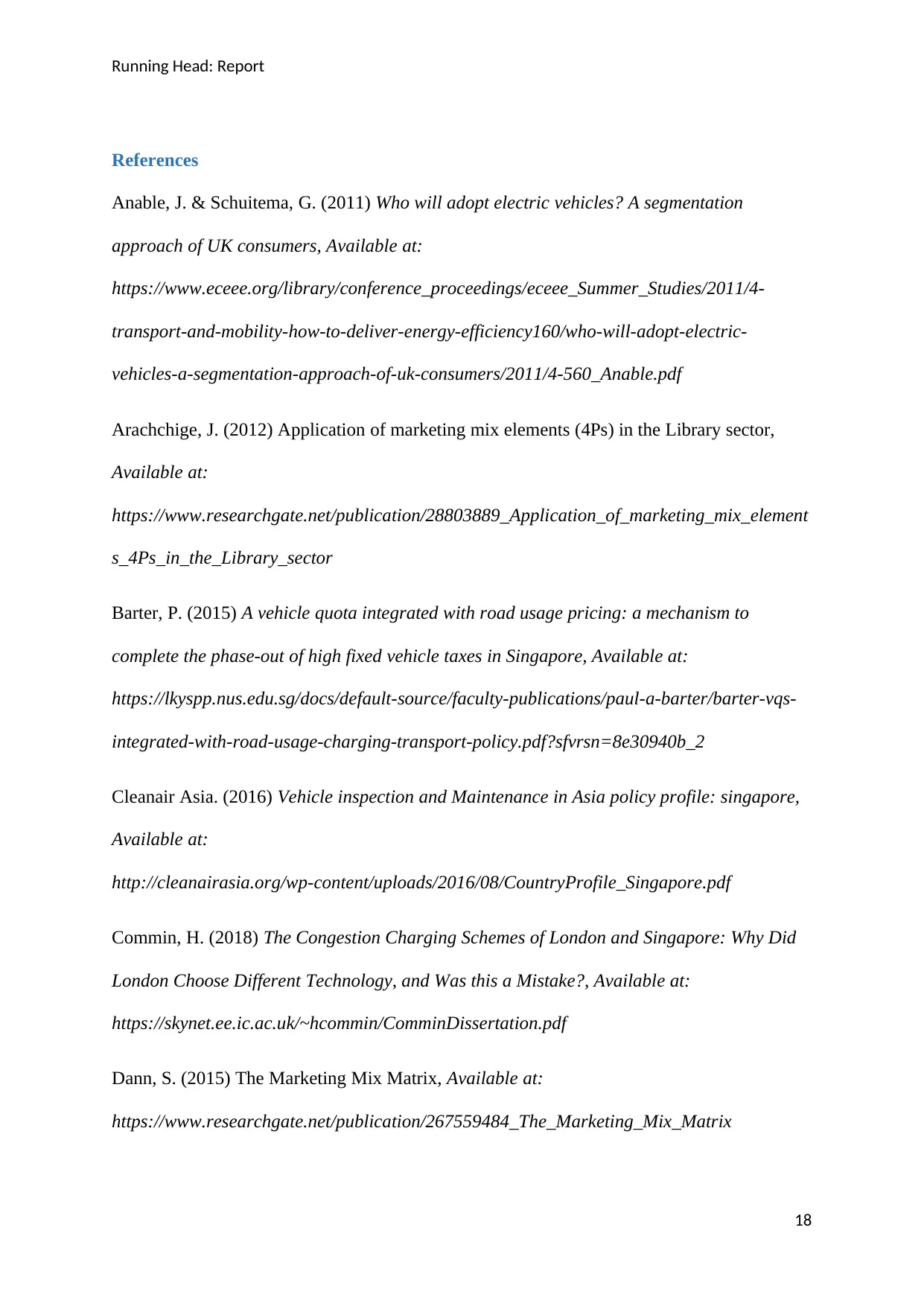
Running Head: Report
References
Anable, J. & Schuitema, G. (2011) Who will adopt electric vehicles? A segmentation
approach of UK consumers, Available at:
https://www.eceee.org/library/conference_proceedings/eceee_Summer_Studies/2011/4-
transport-and-mobility-how-to-deliver-energy-efficiency160/who-will-adopt-electric-
vehicles-a-segmentation-approach-of-uk-consumers/2011/4-560_Anable.pdf
Arachchige, J. (2012) Application of marketing mix elements (4Ps) in the Library sector,
Available at:
https://www.researchgate.net/publication/28803889_Application_of_marketing_mix_element
s_4Ps_in_the_Library_sector
Barter, P. (2015) A vehicle quota integrated with road usage pricing: a mechanism to
complete the phase-out of high fixed vehicle taxes in Singapore, Available at:
https://lkyspp.nus.edu.sg/docs/default-source/faculty-publications/paul-a-barter/barter-vqs-
integrated-with-road-usage-charging-transport-policy.pdf?sfvrsn=8e30940b_2
Cleanair Asia. (2016) Vehicle inspection and Maintenance in Asia policy profile: singapore,
Available at:
http://cleanairasia.org/wp-content/uploads/2016/08/CountryProfile_Singapore.pdf
Commin, H. (2018) The Congestion Charging Schemes of London and Singapore: Why Did
London Choose Different Technology, and Was this a Mistake?, Available at:
https://skynet.ee.ic.ac.uk/~hcommin/ComminDissertation.pdf
Dann, S. (2015) The Marketing Mix Matrix, Available at:
https://www.researchgate.net/publication/267559484_The_Marketing_Mix_Matrix
18
References
Anable, J. & Schuitema, G. (2011) Who will adopt electric vehicles? A segmentation
approach of UK consumers, Available at:
https://www.eceee.org/library/conference_proceedings/eceee_Summer_Studies/2011/4-
transport-and-mobility-how-to-deliver-energy-efficiency160/who-will-adopt-electric-
vehicles-a-segmentation-approach-of-uk-consumers/2011/4-560_Anable.pdf
Arachchige, J. (2012) Application of marketing mix elements (4Ps) in the Library sector,
Available at:
https://www.researchgate.net/publication/28803889_Application_of_marketing_mix_element
s_4Ps_in_the_Library_sector
Barter, P. (2015) A vehicle quota integrated with road usage pricing: a mechanism to
complete the phase-out of high fixed vehicle taxes in Singapore, Available at:
https://lkyspp.nus.edu.sg/docs/default-source/faculty-publications/paul-a-barter/barter-vqs-
integrated-with-road-usage-charging-transport-policy.pdf?sfvrsn=8e30940b_2
Cleanair Asia. (2016) Vehicle inspection and Maintenance in Asia policy profile: singapore,
Available at:
http://cleanairasia.org/wp-content/uploads/2016/08/CountryProfile_Singapore.pdf
Commin, H. (2018) The Congestion Charging Schemes of London and Singapore: Why Did
London Choose Different Technology, and Was this a Mistake?, Available at:
https://skynet.ee.ic.ac.uk/~hcommin/ComminDissertation.pdf
Dann, S. (2015) The Marketing Mix Matrix, Available at:
https://www.researchgate.net/publication/267559484_The_Marketing_Mix_Matrix
18
Paraphrase This Document
Need a fresh take? Get an instant paraphrase of this document with our AI Paraphraser
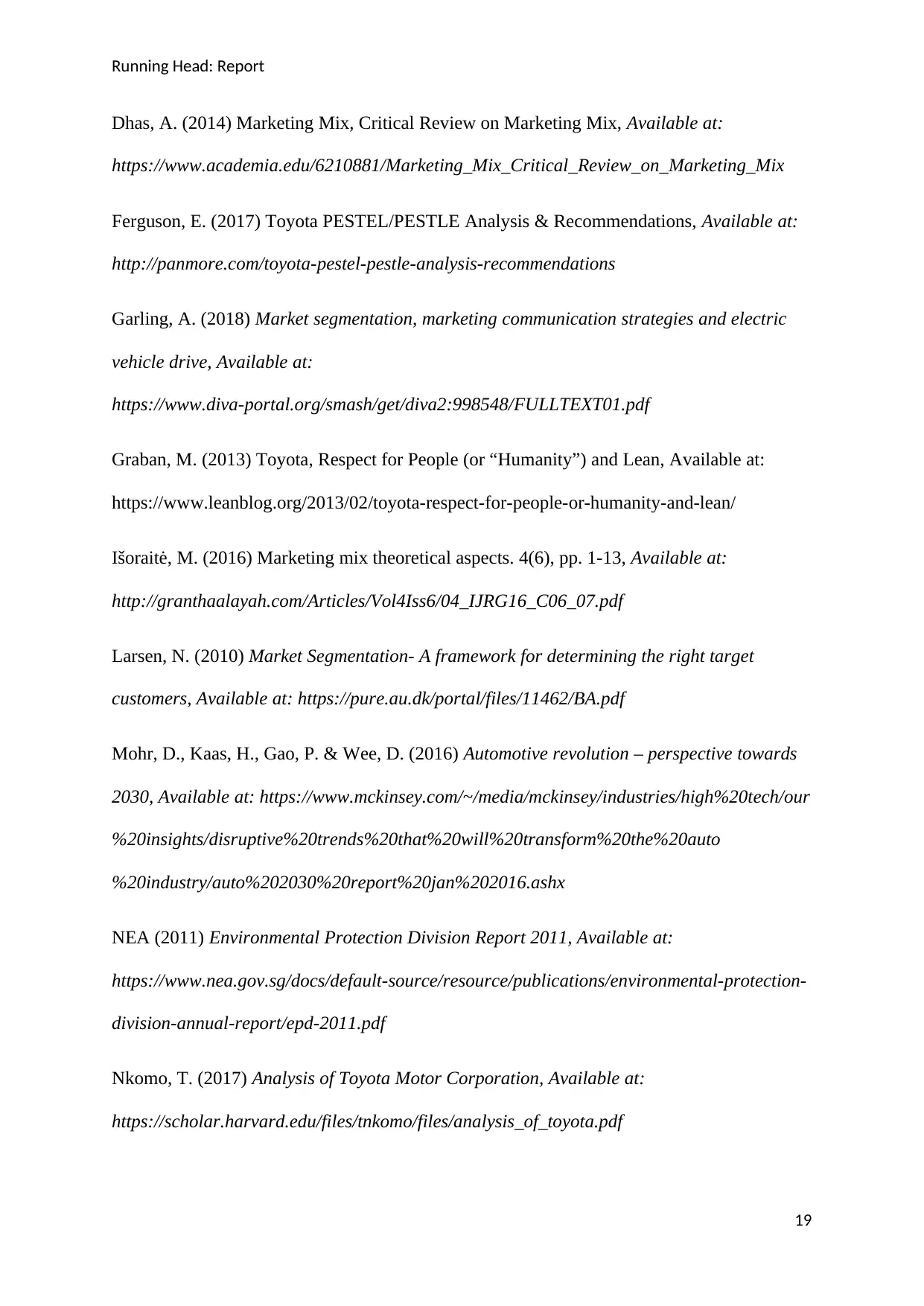
Running Head: Report
Dhas, A. (2014) Marketing Mix, Critical Review on Marketing Mix, Available at:
https://www.academia.edu/6210881/Marketing_Mix_Critical_Review_on_Marketing_Mix
Ferguson, E. (2017) Toyota PESTEL/PESTLE Analysis & Recommendations, Available at:
http://panmore.com/toyota-pestel-pestle-analysis-recommendations
Garling, A. (2018) Market segmentation, marketing communication strategies and electric
vehicle drive, Available at:
https://www.diva-portal.org/smash/get/diva2:998548/FULLTEXT01.pdf
Graban, M. (2013) Toyota, Respect for People (or “Humanity”) and Lean, Available at:
https://www.leanblog.org/2013/02/toyota-respect-for-people-or-humanity-and-lean/
Išoraitė, M. (2016) Marketing mix theoretical aspects. 4(6), pp. 1-13, Available at:
http://granthaalayah.com/Articles/Vol4Iss6/04_IJRG16_C06_07.pdf
Larsen, N. (2010) Market Segmentation- A framework for determining the right target
customers, Available at: https://pure.au.dk/portal/files/11462/BA.pdf
Mohr, D., Kaas, H., Gao, P. & Wee, D. (2016) Automotive revolution – perspective towards
2030, Available at: https://www.mckinsey.com/~/media/mckinsey/industries/high%20tech/our
%20insights/disruptive%20trends%20that%20will%20transform%20the%20auto
%20industry/auto%202030%20report%20jan%202016.ashx
NEA (2011) Environmental Protection Division Report 2011, Available at:
https://www.nea.gov.sg/docs/default-source/resource/publications/environmental-protection-
division-annual-report/epd-2011.pdf
Nkomo, T. (2017) Analysis of Toyota Motor Corporation, Available at:
https://scholar.harvard.edu/files/tnkomo/files/analysis_of_toyota.pdf
19
Dhas, A. (2014) Marketing Mix, Critical Review on Marketing Mix, Available at:
https://www.academia.edu/6210881/Marketing_Mix_Critical_Review_on_Marketing_Mix
Ferguson, E. (2017) Toyota PESTEL/PESTLE Analysis & Recommendations, Available at:
http://panmore.com/toyota-pestel-pestle-analysis-recommendations
Garling, A. (2018) Market segmentation, marketing communication strategies and electric
vehicle drive, Available at:
https://www.diva-portal.org/smash/get/diva2:998548/FULLTEXT01.pdf
Graban, M. (2013) Toyota, Respect for People (or “Humanity”) and Lean, Available at:
https://www.leanblog.org/2013/02/toyota-respect-for-people-or-humanity-and-lean/
Išoraitė, M. (2016) Marketing mix theoretical aspects. 4(6), pp. 1-13, Available at:
http://granthaalayah.com/Articles/Vol4Iss6/04_IJRG16_C06_07.pdf
Larsen, N. (2010) Market Segmentation- A framework for determining the right target
customers, Available at: https://pure.au.dk/portal/files/11462/BA.pdf
Mohr, D., Kaas, H., Gao, P. & Wee, D. (2016) Automotive revolution – perspective towards
2030, Available at: https://www.mckinsey.com/~/media/mckinsey/industries/high%20tech/our
%20insights/disruptive%20trends%20that%20will%20transform%20the%20auto
%20industry/auto%202030%20report%20jan%202016.ashx
NEA (2011) Environmental Protection Division Report 2011, Available at:
https://www.nea.gov.sg/docs/default-source/resource/publications/environmental-protection-
division-annual-report/epd-2011.pdf
Nkomo, T. (2017) Analysis of Toyota Motor Corporation, Available at:
https://scholar.harvard.edu/files/tnkomo/files/analysis_of_toyota.pdf
19
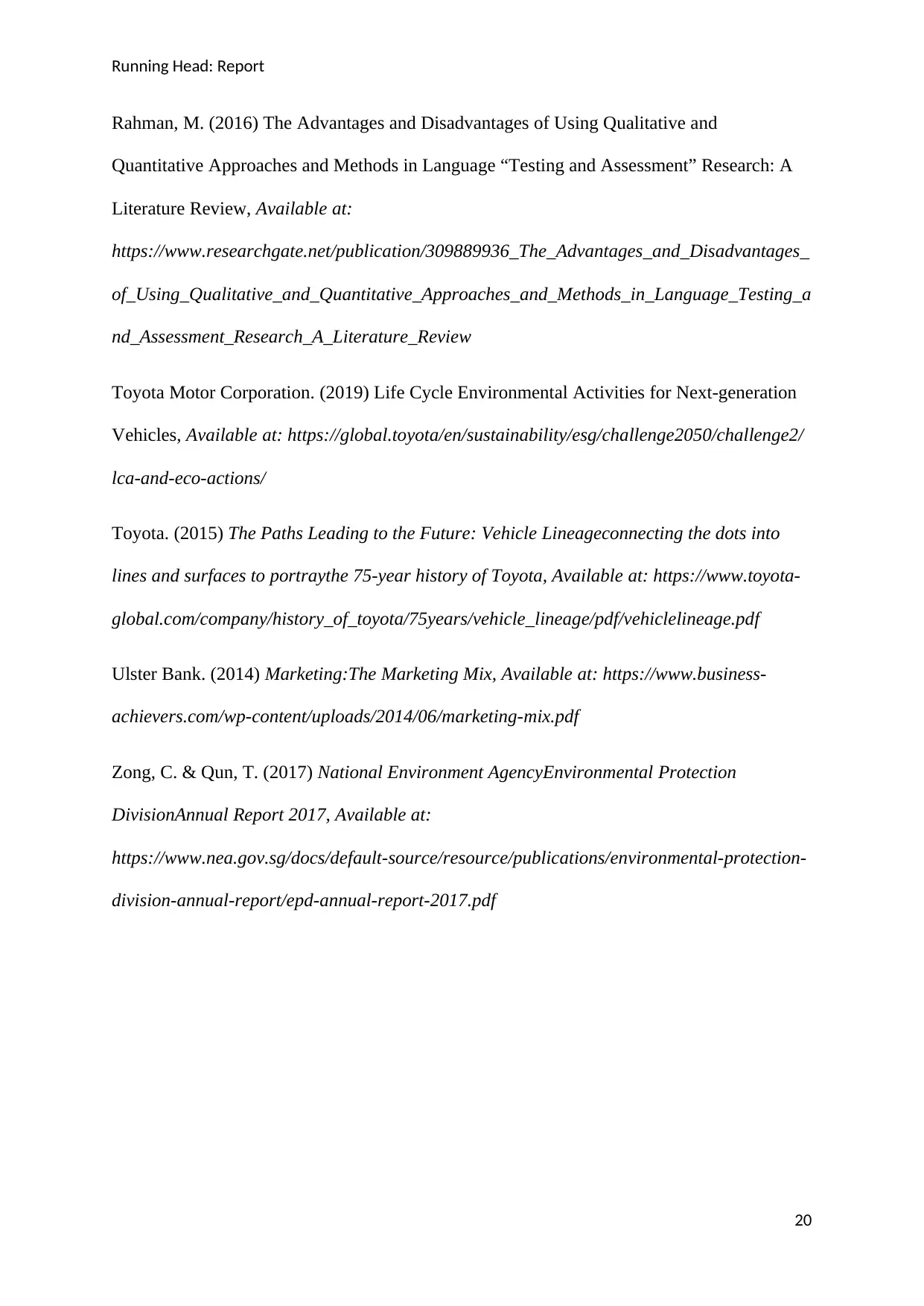
Running Head: Report
Rahman, M. (2016) The Advantages and Disadvantages of Using Qualitative and
Quantitative Approaches and Methods in Language “Testing and Assessment” Research: A
Literature Review, Available at:
https://www.researchgate.net/publication/309889936_The_Advantages_and_Disadvantages_
of_Using_Qualitative_and_Quantitative_Approaches_and_Methods_in_Language_Testing_a
nd_Assessment_Research_A_Literature_Review
Toyota Motor Corporation. (2019) Life Cycle Environmental Activities for Next-generation
Vehicles, Available at: https://global.toyota/en/sustainability/esg/challenge2050/challenge2/
lca-and-eco-actions/
Toyota. (2015) The Paths Leading to the Future: Vehicle Lineageconnecting the dots into
lines and surfaces to portraythe 75-year history of Toyota, Available at: https://www.toyota-
global.com/company/history_of_toyota/75years/vehicle_lineage/pdf/vehiclelineage.pdf
Ulster Bank. (2014) Marketing:The Marketing Mix, Available at: https://www.business-
achievers.com/wp-content/uploads/2014/06/marketing-mix.pdf
Zong, C. & Qun, T. (2017) National Environment AgencyEnvironmental Protection
DivisionAnnual Report 2017, Available at:
https://www.nea.gov.sg/docs/default-source/resource/publications/environmental-protection-
division-annual-report/epd-annual-report-2017.pdf
20
Rahman, M. (2016) The Advantages and Disadvantages of Using Qualitative and
Quantitative Approaches and Methods in Language “Testing and Assessment” Research: A
Literature Review, Available at:
https://www.researchgate.net/publication/309889936_The_Advantages_and_Disadvantages_
of_Using_Qualitative_and_Quantitative_Approaches_and_Methods_in_Language_Testing_a
nd_Assessment_Research_A_Literature_Review
Toyota Motor Corporation. (2019) Life Cycle Environmental Activities for Next-generation
Vehicles, Available at: https://global.toyota/en/sustainability/esg/challenge2050/challenge2/
lca-and-eco-actions/
Toyota. (2015) The Paths Leading to the Future: Vehicle Lineageconnecting the dots into
lines and surfaces to portraythe 75-year history of Toyota, Available at: https://www.toyota-
global.com/company/history_of_toyota/75years/vehicle_lineage/pdf/vehiclelineage.pdf
Ulster Bank. (2014) Marketing:The Marketing Mix, Available at: https://www.business-
achievers.com/wp-content/uploads/2014/06/marketing-mix.pdf
Zong, C. & Qun, T. (2017) National Environment AgencyEnvironmental Protection
DivisionAnnual Report 2017, Available at:
https://www.nea.gov.sg/docs/default-source/resource/publications/environmental-protection-
division-annual-report/epd-annual-report-2017.pdf
20
1 out of 21
Related Documents
Your All-in-One AI-Powered Toolkit for Academic Success.
+13062052269
info@desklib.com
Available 24*7 on WhatsApp / Email
![[object Object]](/_next/static/media/star-bottom.7253800d.svg)
Unlock your academic potential
© 2024 | Zucol Services PVT LTD | All rights reserved.





